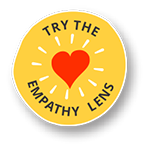Provocation & Installation
Stimulating curiosity and creativity to creation.
Try the empathy lens:
Split your teacher team into two groups and give them different tasks.
Ask one group to complete an artistic task, like writing a poem, or making a collage, or finishing a set drawing. With the other group, give them some materials and a word (like love, or generosity) and ask them to build whatever they want.
Once both groups are done, get their insights on how the process of creation and of being creative was different for both.
We experienced
When children start exploring their curiosity without emphasis on the end goal but purely for the joy of doing it, an amazing journey of creativity unfolds.
Kiran shares the inspiration behind the development of this process.
Our Insights
- Often, children feel under pressure to produce something wonderful when engaging in creative work, and thus see themselves as not creative if they cannot achieve this. True creativity can only be experienced when children work in a non-threatening space and have the freedom to express their voice and refine their output.
- While observing the practices at Reggio Emilia, we saw children being given the time, space and support to explore an idea they were curious about. Through an iterative process where they themselves built layer upon layer to express their thinking and imagination.
- The iterative process built not just self-confidence but also a number of other skills, Including creative thinking and ability to enhance their senses.
it were possible to eliminate fear and judgement from the creative process and thus allow children to truly illuminate themselves?
We designed
A process that allowed children the time for their curiosity to take shape, deepen and manifest into a creation.
A journey that isn’t about the end-goal but the iteration and refinement that goes into getting there.
A Provocation is the starting point of this journey, a spark of curiosity that has the potential to be made into a sustained, continuous trend.
Children question and explore the idea in many forms, imagining and illustrating as it grows organically, with layers being added each time it is revisited.
When an Installation is created at the end of this journey, it becomes an expression of the interpretations and stories that have been encountered and expanded on, during their exploration.
Here is What we Do
This video showcases the process from curiosity to creativity.
In this video you will see an example of how this process has been run from start to finish. In this particular instance, you will see a journey of curiosity and creativity culminating into a beautiful installation. Do note that not every provocation needs to end with an installation, it depends how the students want to express their journey
Examples of Provocation and Installation:
-
4:55
a) Water as Provocation:
This video showcases how a teacher used her students curiosity about water and developed their understanding through an interesting journey of installation.
-
4:35
b) Installation Case Study
This video gives an in depth illustration of how a teacher and her students together showcase their understanding and learning journey through an installation.
Meet the Stakeholder:
Eduhero Sabina Zamindar has been one of the students favourite teachers at the Riverside School since 2012. She has immense experience working with children in Key Stages 1 and 2 and is an expert at facilitating the exploration and use of different materials, using innovative ideas and techniques to develop creative applications.
-
5:52
FAQ Video
Watch her sharing tips and guidelines on how to plan for and execute Provocation and Installation.
-
3:21
Impact Video
Watch Sabina share about the impact that Provocation and Installation has on students as well as teachers.
Tips for the Leader
- This process is very different from ‘regular’ art and craft lessons because it is not about the quality of the output that the children produce, but rather about teaching them the value of creativity and refinement, and having them take ownership of the lessons. Therefore it is important to take the time and not rush the process in order to really see its long-term benefits.
- It is also important to keep in mind that there is no ‘right’ and ‘wrong’ answer or output in this process. Instead, the key is to keep nudging the children’s imagination and help them explore the rationale for the choices they are making.
- Provocations and Installations are a great opportunity to foster collaboration between teachers as they can all contribute based on their strengths and interests.
Share with us your experience of how you have used this process in your context, any challenges you might have faced or just inspire us with your story :-)
Still Curious?
Write us any questions you have about this process, and we’ll get back to you.
Want Feedback
Upload a glimpse of your practice - a classroom video & photos of plans, resource sheets and we’ll get back to you.
Zip all your photos into one file and upload the file here
Want to Inspire ?
Upload your school’s practice as a case study to share with the world!
Document and shoot your practice in an manner that people can understand. The video should not be more than 3-5 mins.

